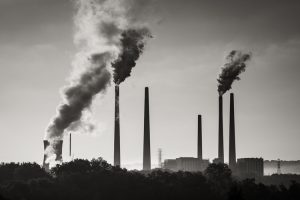A Reason for Optimism in the Climate Crisis
Opinion
May 2, 2022
The Earth is warming, and it’s not cooling off. Each year seems to break some horrible new record. We may eventually reach a tipping point that signals not only the end of humanity but the end of life on earth as we know it. Even while scientists, activists, and much of the younger generation call for action and change, it seems most politicians and business owners are not interested in doing meaningful work while the fossil fuel industry works actively against climate change, leaving most people to feel cheated and hopeless because humanity can’t overcome its greed and obsession with personal gain.
This leaves many people feeling discouraged. To them, the future looks dreadful. Younger generations feel particularly anxious and depressed because they don’t get to look forward to a lifetime of opportunity. Many are even afraid to have children for fear of having them live in a near-apocalyptic world. It feels like it’s too late for the human race and that our fate is sealed. But that’s (probably) not true.
Despite the seriousness of the climate crisis, over the years, a stigma has emerged that we are doomed and there is not enough time left to reverse the changes. This idea has rooted itself in many people, myself included, and this has affected the way we discuss this climate catastrophe. We think we are doomed and absorb all of our information through this filter. Most people believe that the end is unavoidable now. As of 2022, the global average temperature has risen about 1 degrees Celsius ( about 1.7 degrees Fahrenheit) since preindustrial times. The Paris Agreement’s (adopted on 12 December) main goal was to limit global warming to around 1.5 degrees celsius. But it looks unlikely that we will meet it. With the warming that we already have today, hot places will get hotter, wet places will get wetter, and the risk and strength of extreme weather events will increase significantly.
Warming temperatures to 2 degrees cause all of these extremes to be more extreme, making them more common, and more ecosystems will be put under stress and many may not even survive. If it reaches 3 degrees celsius, major regions of the earth, especially in countries that are still developing, might become uninhabitable due to a lack of food for the population. Heatwaves will become a major global issue. Some of the bigger natural systems on earth such as the nitrogen cycle, the water cycle, and the carbon cycle will begin to break down. Hurricanes, fires, and draughts will all increase in scale and frequency, causing trillions of dollars in damage. Hundreds of millions of people will need to leave their homes.
If the temperature increases past 4 degrees celsius, things will truly become apocalyptic. A decade ago, due to a lack of action and perspective, many scientists believed we were heading towards a 4+ degree world, and this belief was then subsequently adopted by the media and then the general public. Luckily this future is not as likely as before. Even if current climate change policies stagnate, we’re more likely to end up with 3-degree warming by the end of 2100. This is still terrifying and unacceptable. But comparatively, it can also be seen as good news. It may not seem like it, but this signals that over the past decade, we’ve seen enough progress that most scientists now think we have likely avoided the worst possible scenario. Although much risk still exists, we can pretty confidently say that humanity won’t go extinct. And from there, things will eventually change.
So what has changed? Well, you probably already know this, but climate change policies all over the world have done nothing substantial. Instead of holding the main polluters accountable and adapting our lifestyles to be more sustainable, we mostly did nothing. And while this is mostly true and this is something we should be angry about it, it’s not the whole picture. Even though climate change policies were neglected and there was ongoing misinformation campaigns from the fossil fuel industry, there WAS progress.
Between 2000 and 2010, total greenhouse gas emissions had grown by around 24%, over 3 times the increase in the previous decade. Considering that for countries that were expanding their infrastructures like China and India, coal was the cheapest fuel for growth, while countries who have already built most of their infrastructure using coal as a basis seemed uninterested in any other source, many people expected these trends to continue. The next decade turned out to be different though. Coal-burning in countries like India and China has been slowed down or leveled off. And it has noticeably fallen in more coal-dependent countries like the UK and US. Since 2015, three-quarters of planned coal plants have been canceled and 44 countries have agreed to stop making them.
This was something we could only dream about ten years ago, but now it is very much a reality: coal is dying. It’s just not competitive anymore because technologies that we thought would remain expensive have matured rapidly instead. I’m sure we’ve all seen the commercials telling Pennsylvania homeowners that they can get rid of electrical bills completely and even receive government subsidies if they just switch to renewable energy. In just one decade, wind energy got three times cheaper, and solar energy is now 4 times as cheap. Both wind and solar are significantly cheaper the coal and other fossil fuel-based energies, despite the massive subsidies, investments, and global infrastructure propping up fossil fuels. We are at the point at which not decarbonizing is a bad business decision. 25 times more solar and almost 5 times more wind electricity is produced today compared to ten years ago. While this still isn’t enough to undo the major environmental disaster we have created, it is much more progress than we have ever seen. Not to mention that it isn’t just the renewable energy that has seen major progress: throughout the economy, people are working on and improving technology to lower emissions such as LEDs, electric heating, better insulation, and even ships traveling at slower speeds to save fuel.
Everywhere we look, we see human ingenuity being used to help fix this larger problem. More and more people are prioritizing preventing rapid climate change and are coming up with solutions that, while on their own won’t stop global warming, all add up to help reduce emissions in even the unlikeliest of places.
However, let’s not get carried away; all of this change and progression is great but it’s not enough. We are still doing too little, and technology alone is not going to magically solve everything. We need to use fewer resources and use them longer, design consumer goods that are repairable as well as durable, and decrease our energy requirements.
It will be hard work, but for the first time ever, enough positive trends have accumulated and there is actually some good news revealing a clear path toward reversing the change and becoming a sustainable society. Even though there wasn’t proper financial and political support, and despite fossil fuel lobbying, we were still able to make some progress. Now just imagine what we could do when climate change finally gets the political attention and funding it needs. But if the situation is so dire, why focus on these positive aspects? Well, If we want the world to change, we first need to believe that change is possible.


